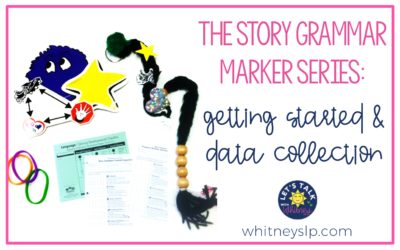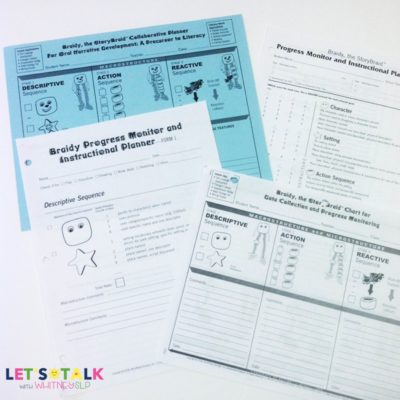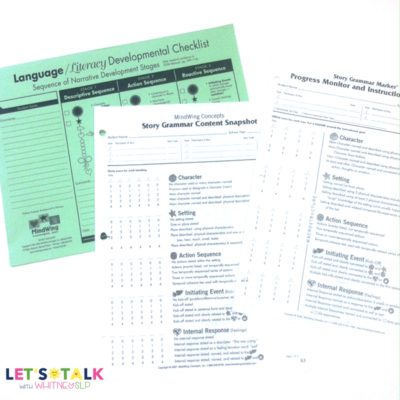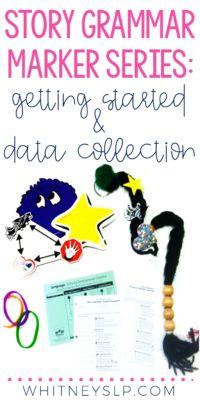Welcome back to the series of blog posts all about Story Grammar Marker! Next up is Story Grammar Marker: Getting Started and Data Collection. I do need to add a disclaimer here: There is a whole separate training and teacher’s manual on data collection. I can’t possibly cover even close to half of what is available on this simple blog post. So if you like what you see and don’t have the data collection manual, I highly recommend you get it. I have found it to be a crucial part to the teaching process.

After today’s blog, if you have questions or want more information, I will be glad to answer your questions. However, I also encourage you to check out the MindWing Concept’s website. There you will find contact information, research (yes, SGM is evidence-based), SGM forums, frequently asked questions, video clips, and much more!
So let’s get started:
As in any therapy program, you need baseline data. Baseline data is super easy with Story Grammar Marker. All you have to do is pick out a book or short story that you have not previously taught. Read it to the student and show them the pictures, and then have them retell the story back to you. Encourage them to include as much detail as they can remember. You can encourage them along by asking questions like “Is that all?” or “Tell me more,” but be careful not to cue or help them.
Make sure you provide verbal encouragement, as this can be frustrating to a student who can’t remember many details. If at all possible, it is best to record their retell so you don’t miss anything, as you will need to analyze it later.
Macrostructure Vs. Microstructure:
After you finish recording their story retell, go back and write each and every word they said down to analyze their retell for macrostructure and microstructure. Macrostructure includes the story content, such as the story elements. Not all stories are complete episodes with every story element included in the Story Braid. Some stories, poems, etc. are descriptive by nature and don’t necessarily tell a story from start to finish. The macrostructure of the retell includes the story elements and details that were included in the story by the author.
The microstructure includes the “extra things” such as conjunctions (FANBOYS), mental state verbs (think, know, remembered, dreamed), adverbs (here, again, slowly, suddenly), elaborated noun phrases (noun + adjective(s), and linguistic verbs (shouted, whispered, yelled).
Both macrostructure and microstructure are very important. The student may have neither, one or the other, or both. You can tell a student who lacks microstructure when you see or hear lists, simple sentences, etc. Their story lacks the “flow.”
Data Collection Tools
The SGM teacher’s manual has wonderful data collection worksheets and progress monitoring pages. The Language/Literacy Developmental Checklist: Sequence of Narrative Developmental Stages includes a breakdown of each of the sequences: descriptive, action, reactive, abbreviated episode, complete episode, complex episode, and interactive episode. This developmental chart also tells you which sequence the students should be able to do by which grade level. These are great for analyzing your baseline data and progress monitoring. You can determine where the student is before being taught the story elements and SGM, and then see how they are progressing, through additional story retells (with different books, of course!)
The Progress Monitor and Instructional Planner worksheet is also an excellent tool for progress monitoring. It assigns points for each story element based on how well the student describes the element. The point system is easy to use to determine if the students are making progress. It also helps to identify specific areas that need to be addressed to a greater extent.
The SGM Data Collection Manual is filled with a plethora of information and printables perfect for keeping data on all of your students. The data collection forms are easy to complete and simple to read, making it very easy to track progress. There are data sheets for students using Braidy, as well as students using the story braids.


After Collecting Baseline Data…
After you get your baseline data, you can begin teaching Story Grammar Marker. I’ve said it before, but the wonderful thing about SGM is the flexibility. You can make it work for any age, any grade, and any ability level. I have probably never taught it the exact same way twice, but I always start by teaching the students about the icons. For my older kids who can handle it, I do a quick overview of all of the icons and then go back and spend time on each one until we have explored it completely. For the younger students, I start with character and feelings. (This also works great with those students with Autism). Once they know character, we talk about setting. The icons also go along great when teaching WH questions. (Who-character, Where-setting, etc.)
I hope you found today’s post on Story Grammar Marker: Getting Started and Data Collection helpful. Do you have any questions? I’d love to hear from you! You can click the link below to find the next post in this series.
Story Grammar Marker: SGM and Autism











